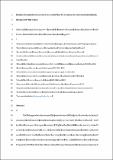Benthic foraminiferal turnover across the Dan-C2 event in the eastern South Atlantic Ocean (ODP Site 1262)
Abstract
The Paleogene was punctuated by perturbations of the global carbon cycle, many associated with transient global warming events (hyperthermals). The Dan-C2 event (~160 kyr after Cretaceous/Paleogene boundary; K/Pg) was the oldest of these eccentricity-linked carbon cycle disturbances (ELCD). In contrast to other hyperthermals, the Dan-C2 event was not characterised by bottom water warming, and surface water warming probably was not global. Benthic foraminiferal assemblages across Dan-C2 at SE Atlantic Ocean Drilling Program (ODP) Site 1262 are diverse and strongly dominated by calcareous species. Epifaunal and infaunal morphogroups are equally abundant, suggesting meso-oligotrophic seafloor conditions. Assemblages decreased in diversity gradually before Dan-C2, and Nuttallides truempyi decreased in relative abundance while Stensioeina beccariiformis and the agglutinant Spiroplectammina spectabilis increased, suggesting enhanced food supply to the seafloor. Benthic foraminifera were not highly affected by the Dan-C2 event. An increase in relative abundance of the opportunistic species Bulimina kugleri and Seabrookia cretacea after Dan-C2 points to a change in the type of organic matter arriving at the seafloor. These changes may have been caused by ongoing environmental and/or evolutionary instability following K/Pg mass extinction of oceanic plankton. Variability in composition of pelagic ecosystems, thus the type and/or amount of food arriving at the seafloor, may have been caused by the gradual recovery of pelagic ecosystems after that extinction, possibly affected by warming and pH changes due to Deccan volcanism.
Citation
Arreguín-Rodríguez , G J , Barnet , J S K , Leng , M J , Littler , K , Kroon , D , Schmidt , D , Thomas , E & Alegret , L 2021 , ' Benthic foraminiferal turnover across the Dan-C2 event in the eastern South Atlantic Ocean (ODP Site 1262) ' , Palaeogeography, Palaeoclimatology, Palaeoecology , vol. 572 , 110410 . https://doi.org/10.1016/j.palaeo.2021.110410
Publication
Palaeogeography, Palaeoclimatology, Palaeoecology
Status
Peer reviewed
ISSN
0031-0182Type
Journal article
Description
G.J.A.R. and L.A. acknowledge funding from projects CGL2017-84693-R and PID2019-105537RB-I00 (Spanish Ministry of Science and Innovation and FEDER funds), and from Consolidated Group E05 (Government of Aragon/Fondo Europeo de Desarrollo Regional). E.T. recognises partial funding by NSF_OCE 1536611. G.J.A.R thanks the Consejo Nacional de Ciencia y Tecnología (Conacyt, México) for her predoctoral fellowship. J.S.K.B. and K.L. acknowledge funding from the Natural Environment Research Council (NERC) Isotope Geosciences Facility at the British Geological Survey (IP-1581–1115) and D.N.S. support from the Royal Society via Wolfson Merit award. This research used samples provided by the Ocean Drilling Program (ODP), sponsored by the U.S. National Science Foundation (NSF) and participating countries under management of Joint Oceanographic Institutions (JOI), Inc.Collections
Items in the St Andrews Research Repository are protected by copyright, with all rights reserved, unless otherwise indicated.

